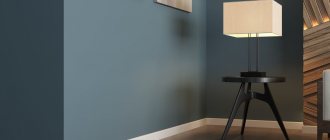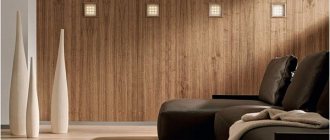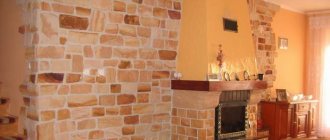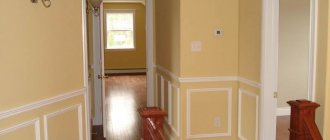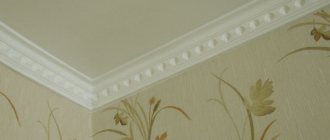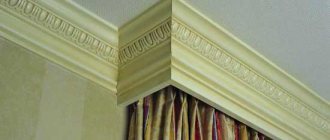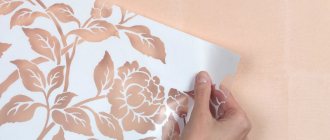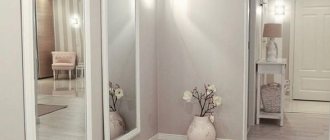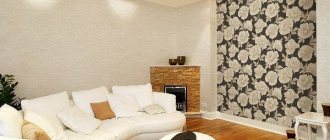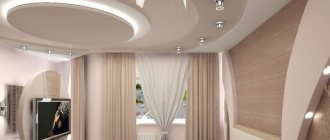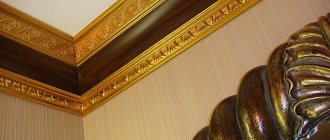Modern renovations are increasingly moving away from standards. Simple urban style is being replaced by more elegant and flexible design solutions. Straight lines are replaced by curvilinear, smooth, rounded shapes, so there is a need for new technologies for interior decoration.
Facing materials can be very different, but it is difficult to imagine a renovated space without skirting boards; this finishing element is, without a doubt, indispensable in any interior. In this article we will tell you what a flexible floor and ceiling plinth is, and how to bend a plinth from different materials with your own hands.
Flexible ceiling plinth allows you to trim complex rounded shapes
Why do you need a flexible floor plinth?
The design of curved walls, round columns and half-columns often becomes a problem. The walls in the bay window are also usually round. Some people make rounded corners. All this looks beautiful and adds uniqueness to the house, but problems arise in the finishing. One of them is in the selection of skirting boards. They are usually in the form of slats, and quite rigid ones. The question arises - how to design curved surfaces?
To decorate curved walls and columns there is a special plinth - soft, flexible, elastic
In general, there are flexible skirting boards. They are also called bendable, radius, soft, radial, or they are written as such - “for columns”. There is also plinth tape. This is a strip of vinyl divided along a fold line (pictured below). There are products that are more similar to traditional skirting boards. For example, FLEX LINE CEZAR, SALAG, FN Neuhofer Holz, Korner IDEA 80 (for painting) and Ultima 80, Nova 70 with cable duct, Arbiton made of thin metal. Some materials can be made to bend when exposed to temperature or special treatment. In general, there are opportunities.
Advice from professionals
The installation procedure for PVC skirting boards is not particularly complicated. But in it, as in any other business, there are subtleties that help get the job done faster and easier. Here are some tips from renovation professionals:
- The work of installing skirting boards can be done alone. But it is much more convenient to work with an assistant.
- Before laying the cables in the channel, it is better to grab them in several places in a bundle with tape or special cable ties. To prevent the rigid cable from ripping out of the channel, you can secure it in place with double-sided tape.
We also recommend watching videos in which all stages of work are clearly shown:
Installing PVC skirting boards is not particularly difficult. If everything is done carefully, even a less-skilled repairman can achieve excellent results. And then the room will take on a finished look.
Flexible floor plinth: materials and profiles
The most obvious and simple way is to use a flexible floor plinth to decorate columns, bay windows, etc. There are some, and in sufficient quantities. That's just bad luck. All of them are made of different types of plastic:
- polyvinyl chloride (PVC);
- silicone;
- rubber;
- vinyl.
Why know the material? To choose the glue, because almost all of them are mounted with glue. But not every adhesive, even a universal one, will help you. There may be problems with the selection of glue. But more on that later.
Flexible vinyl floor plinth can bend to any radius. This is a plastic tape divided into two parts by a longitudinal groove. Along this groove and bend it
Some flexible skirting boards are rolled into rolls. There are no problems with flexibility and giving the required radius. They can be bent into a ring of small diameter. But there are problems with choosing colors or heights. If the columns stand separately, then this is easier. The task is to more or less get into the color and “format” of the skirting boards. But what if it’s just a rounding or a semi-column? Beautifully joining two skirting boards that are different in height (and often also in material) is a non-trivial task and not everyone succeeds.
There is a way out: use flexible skirting boards everywhere. And on straight sections too. The good news is that no additional elements are needed. And the fit even to curved walls is perfect. The bad news is that they often have too little “depth.” If the floor covering is laid with a large temperature gap (the gap between the covering and the wall), the protrusion of the bottom shelf may not be enough to cover this gap.
The soft polyvinyl chloride plinth has a sufficient degree of flexibility so that any curved surface can be finished
There are flexible skirting boards that are indistinguishable from ordinary plastic ones. In this case, the labeling should indicate that it is flexible. Then that’s what they write – “flexible” or “for columns”, or it’s written in English as Flexible. The brands Caesar, Salag, and Holz have such skirting boards. Moreover, these companies produce skirting boards for smooth walls. But the height of flexible and rigid ones, and their appearance, are different. That's such a bad thing.
Bottom line
If the interior of the room contains columns, bay windows, or semicircular projections, then you can use ready-made bending skirting boards to frame them, or you can bend the floor and ceiling edging yourself. Flexible framing will add style and softness to the room, making it more cozy, individual, and comfortable.
Modern renovations are increasingly moving away from standards. Simple urban style is being replaced by more elegant and flexible design solutions. Straight lines are replaced by curvilinear, smooth, rounded shapes, so there is a need for new technologies for interior decoration.
Facing materials can be very different, but it is difficult to imagine a renovated space without skirting boards; this finishing element is, without a doubt, indispensable in any interior. In the article we will tell you what flexible and is, and how to bend a plinth from different materials with your own hands.
Flexible ceiling plinth allows you to trim complex rounded shapes
How to decorate without a special radial plinth
If you don’t like the flexible plinth for the floor or are somehow unsatisfied with it, you can try to design a column, a rounded corner, or just a curved wall differently. Well, for round columns there is a cardinal solution - to make a rectangular (hexagonal, octagonal) base and decorate it with a regular plinth. But there are other options:
- Use cork plinth. It bends very well. And it will go around the columns too. But it will need to be installed throughout the room, since it is difficult to find an analogue. Don't think that it is very soft and there will be dents. Firstly, it is not that soft. Secondly, according to the technology it is covered with several layers of varnish. As a result, it is no softer than pine.
You can use cork as a flexible (and other) plinth. It bends very well in any shape and thickness - Make a gypsum plinth. Place formwork around the columns, secure it and fill it with gypsum mortar. You can’t make a complex baseboard shape, but it’s possible to make a simple one.
- Use a flexible threshold. It is used to design the junction of different materials. If you design a wall with a curve, you can attach the guide to the wall. This option is offered by the manufacturers themselves. But there is also a modified version. This is how you can make a plinth for a column. It is necessary to cut off one of the parts - approximately 1 cm from the edge and trim the fastening protrusions so that the bar can be pressed tightly to the surface. You will get a soft plinth with a smoothly rounded top. In this form it is mounted with glue.
You can also close a large temperature gap with a flexible threshold. But the mounting profile in this case is attached to the wall/column
- There is also a flexible aluminum plinth for LED strips. Here you can kill two birds with one stone: make lighting and decorate columns or walls. Only the dimensions of this profile are small. But you can combine something.
You can use a bendable aluminum profile for LED strip as a flexible plinth
Flexible polyurethane
There are types of flexible skirting boards made from polyurethane. They are also known as rubber ones. In general, this type is no different from ordinary skirting boards, but does not break when bent. This was achieved by adding rubber to the original substance during the production of products.
Polyurethane baseboards are not afraid of water, so they can be installed in the bathroom. It is also highly durable, easy to use, and non-toxic. It can be painted in any color you like and thus match the interior. For painting, it is better to use acrylic-based paints, and the process itself is carried out after installing the product. Installation of such a plinth is carried out using special glue.
How to bend a regular plastic skirting board
There are also ways to make a semicircular baseboard for the floor - bend it. And there are two ways. The first one is more fire hazardous, so be careful. You need a large oven and tall, non-flammable stands. Bricks, for example. Place a piece of plinth on the stands and turn on the heat. Heat slowly, setting the maximum to 90-100°C. Have your gloves ready. Add temperature little by little. When you see that the plinth has begun to sag under its own weight, take it out and quickly move it to a column or curved surface to give it the desired shape. But you have to keep it like this until it cools down. For half-columns and round corners there are no problems, but for columns you will have to join two pieces.
If the plastic baseboard is heated, it can be bent
Second way. Try to bend a regular plastic plinth by removing the stiffeners. They are trimmed/cut about a centimeter apart. Maybe less often, maybe more often - it depends on the bending radius and the shape of the plinth. Then heat the bar in the bending areas using a hairdryer. Don't have a hair dryer? Bathing in boiling water may help. When hot, place it in place. The shape is given immediately and fixed immediately.
Work execution technology
Before, it should be steamed and heated to +70°C.
- Pour water into a large saucepan and put it on the fire, bring the water to a boil.
- We hang the baseboard over a stream of steam, so it will heat up and steam for at least 20-30 minutes.
- After the plinth has steamed, you can begin to bend it using one of the following methods:
- We hang the plinth horizontally, securing it in the middle, and tie a weight to its edges, which will give the plinth the desired shape.
- On a certain plane we draw a line corresponding to the desired shape of the plinth, and nail several wooden blocks along it. This way we get a kind of curvilinear shape. Then we insert the steamed plinth between the bars and securely fix it.
- We give the baseboard a chance to dry and cool, after which it will become hard.
Installation methods
The main method of installing flexible floor skirting boards is gluing. Moreover, the adhesive composition is applied both to the wall and to the floor - pay attention to this. After all, it can be more or less easily torn off from the floor covering, but it will be difficult to do this from the wall. If wallpaper is glued to the wall, it makes sense to remove it to the height of the baseboard and glue the baseboard directly to the wall, and not to the wallpaper.
If you apply or select the glue incorrectly, this will be the result
Regardless of the type of plastic from which the flexible floor plinth is made, manufacturers have the same recommendations for gluing: first clean the floor and walls from dust, then degrease. Apply glue only to a dry, grease-free surface.
How to choose an adhesive for gluing flexible skirting boards
The choice of glue must be approached carefully. Installation instructions are often provided with baseboards. It must indicate what types of adhesives can be used. Choose from the list. When choosing an adhesive, read the instructions before use, as there may be differences in gluing technology. If they are not followed, the glue simply will not hold the baseboard. Or there will be cracks, which is no better.
Method of installing flexible skirting boards - with glue
What if the type of glue is not specified? By trial method. Take several types of glue and pieces of plinth. Apply glue according to the instructions and glue two pieces together. To remember, sign the samples. After waiting the required time, try to separate the samples. Use the glue that “holds” best.
What glue can be used to glue flexible skirting boards? Depends on the material. For example, polyvinyl chloride (vinyl, PVC) is glued to mastic, “bostik”, or quick-drying acrylic silicone. Can be used with construction adhesive. Compositions such as “liquid nails” work only those that can glue plastic or rubber. Polyurethane compounds are good, but they are expensive. But before buying them, carefully look at what materials they can glue together and how long they need to be kept in place. The shorter the setting period, the easier it will be for you to work.
Features and secrets of installation
We won’t tell you anything top-secret here. Simple things that can nevertheless affect your work.
- If you bought skirting boards in cold weather, let them warm up before starting installation. Or warm it up yourself with a hair dryer.
- Before applying glue, degrease the baseboards too. This is often forgotten.
- You can try gluing a soft flexible baseboard onto double-sided tape. By the way, there are self-adhesive models. They have an adhesive composition applied to the back and protected with thick tape. In this case, we degrease only those surfaces to which we glue the baseboard.
Installing a flexible plinth on a guide - one of the special models - When gluing, the efforts of your fingers or palm are not always enough. You can press it more tightly to the floor or wall with a non-sharp metal object or a thick piece of plastic.
- When gluing the plinth tape in the corners and on the bends, it must be heated with a hair dryer, then given the desired shape. It is convenient to do this with a spatula with a non-sharp edge. It is best if the metal of the spatula “blade” is thick.
General aspects of working with flexible skirting boards can be seen in training videos. Much becomes clearer.
Possibilities
It should be noted that the finishing materials market quickly responds to the needs of modern renovation. Now there are different models of bendable skirting boards on sale, and while polystyrene strips are very fragile and almost do not bend, then the polyurethane profile with the addition of rubber is very flexible and ductile.
The best solution for finishing a complex curved area with many curves is soft, flexible skirting boards. This is usually vinyl or flexible polyurethane baseboard with a high percentage of rubber. The profile is very elastic and is sold in rolls; it is easy for them to go around both external and internal radius corners.
For example, flexible floor plinths are used in rooms with complex shapes, for arches, columns, rounded podiums, etc., and flexible ceiling plinths are used for finishing curved plasterboard structures or tension systems.
In addition to flexible models, a wide range of curved radius plinths with different diameters and from different materials are available for sale. As a rule, these are wooden and polyurethane segments for a round corner or column.
Flexible, semicircular self-adhesive vinyl plinth, easy to cut and bend to any radius
